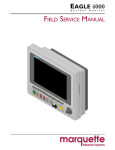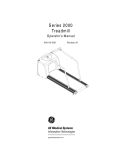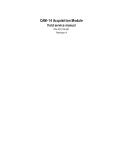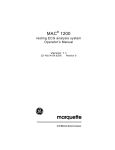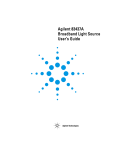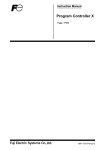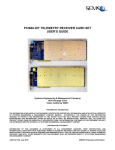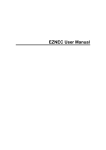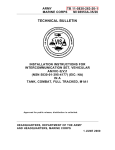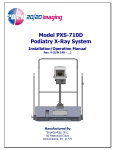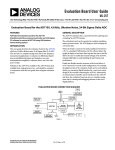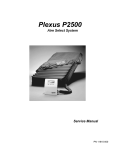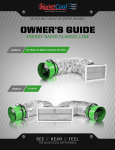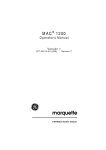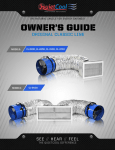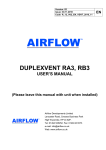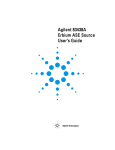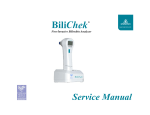Download PRN 50-M (M-Port) and PRN 50 (AutoPort) Digital Writer
Transcript
PRN 50-M (M-Port) and PRN 50 (AutoPort) Digital Writer Service Manual 2006503-001 Revision A 127( Due to continuing product innovation, specifications in this manual are subject to change without notice. Trademarks Listed below are GE Medical Systems Information Technologies trademarks. All other trademarks contained herein are the property of their respective owners. 900 SC, ACCUSKETCH, AccuVision, APEX, AQUA-KNOT, ARCHIVIST, Autoseq, BABY MAC, C Qwik Connect, CardioServ, CardioSmart, CardioSys, CardioWindow, CASE, CD TELEMETRY, CENTRA, CHART GUARD, CINE 35, CORO, COROLAN, COROMETRICS, Corometrics Sensor Tip, CRG PLUS, DASH, Digistore, Digital DATAQ, E for M, EAGLE, Event-Link, FMS 101B, FMS 111, HELLIGE, IMAGE STORE, INTELLIMOTION, IQA, LASER SXP, MAC, MAC-LAB, MACTRODE, MANAGED USE, MARQUETTE, MARQUETTE MAC, MARQUETTE MEDICAL SYSTEMS, MARQUETTE UNITY NETWORK, MARS, MAX, MEDITEL, MEI, MEI in the circle logo, MEMOPORT, MEMOPORT C, MINISTORE, MINNOWS, Monarch 8000, MULTI-LINK, MULTISCRIPTOR, MUSE, MUSE CV, Neo-Trak, NEUROSCRIPT, OnlineABG, OXYMONITOR, Pres-R-Cuff, PRESSURE-SCRIBE, QMI, QS, Quantitative Medicine, Quantitative Sentinel, RAC RAMS, RSVP, SAM, SEER, SILVERTRACE, SOLAR, SOLARVIEW, Spectra 400, Spectra-Overview, Spectra-Tel, ST GUARD, TRAM, TRAM-NET, TRAM-RAC, TRAMSCOPE, TRIM KNOB, Trimline, UNION STATION, UNITY logo, UNITY NETWORK, Vari-X, Vari-X Cardiomatic, VariCath, VARIDEX, VAS, and Vision Care Filter are trademarks of GE Medical Systems Information Technologies registered in the United States Patent and Trademark Office. 12SL, 15SL, Access, AccuSpeak, ADVANTAGE, BAM, BODYTRODE, Cardiomatic, CardioSpeak, CD TELEMETRY®-LAN, CENTRALSCOPE, Corolation, EDIC, EK-Pro, Event-Link Cirrus, Event-Link Cumulus, Event-Link Nimbus, HI-RES, ICMMS, IMAGE VAULT, IMPACT.wf, INTER-LEAD, IQA, LIFEWATCH, Managed Use, MARQUETTE PRISM, MARQUETTE® RESPONDER, MENTOR, MicroSmart, MMS, MRT, MUSE CardioWindow, NST PRO, NAUTILUS, O2SENSOR, Octanet, OMRS, PHi-Res, Premium, Prism, QUIK CONNECT V, QUICK CONNECT, QT Guard, SMART-PAC, SMARTLOOK, Spiral Lok, Sweetheart, UNITY, Universal, Waterfall, and Walkmom are trademarks of GE Medical Systems Information Technologies. © GE Medical Systems Information Technologies, 2001. All rights reserved. T-2 PRN 50-M (M-Port) and PRN 50 (AutoPort) Digital Writer 2006503-001 Revision A 23 March 2001 Contents 1 Introduction . . . . . . . . . . . . . . . . . . . . . . . . . . . . . . . . . . . . 1-1 Manual Information . . . . . . . . . . . . . . . . . . . . . . . . . . . . . . . . . . . . . . . . . . . . . . . . . . 1-3 Revision History . . . . . . . . . . . . . . . . . . . . . . . . . . . . . . . . . . . . . . . . . . . . . . . . . . . 1-3 Purpose of Manual . . . . . . . . . . . . . . . . . . . . . . . . . . . . . . . . . . . . . . . . . . . . . . . . . 1-3 Safety Information . . . . . . . . . . . . . . . . . . . . . . . . . . . . . . . . . . . . . . . . . . . . . . . . . . . 1-4 Responsibility of the Manufacturer . . . . . . . . . . . . . . . . . . . . . . . . . . . . . . . . . . . . . 1-4 Intended Use . . . . . . . . . . . . . . . . . . . . . . . . . . . . . . . . . . . . . . . . . . . . . . . . . . . . . 1-4 Equipment Symbols . . . . . . . . . . . . . . . . . . . . . . . . . . . . . . . . . . . . . . . . . . . . . . . . 1-5 Warnings, Cautions, and Notes . . . . . . . . . . . . . . . . . . . . . . . . . . . . . . . . . . . . . . . 1-5 Service Information . . . . . . . . . . . . . . . . . . . . . . . . . . . . . . . . . . . . . . . . . . . . . . . . . . 1-6 Service Requirements . . . . . . . . . . . . . . . . . . . . . . . . . . . . . . . . . . . . . . . . . . . . . . 1-6 Equipment Identification . . . . . . . . . . . . . . . . . . . . . . . . . . . . . . . . . . . . . . . . . . . . . 1-6 Warranty . . . . . . . . . . . . . . . . . . . . . . . . . . . . . . . . . . . . . . . . . . . . . . . . . . . . . . . . 1-6 2 Equipment Overview . . . . . . . . . . . . . . . . . . . . . . . . . . . . . 2-1 Description of Equipment . . . . . . . . . . . . . . . . . . . . . . . . . . . . . . . . . . . . . . . . . . . . . 2-3 PRN 50-M and PRN 50 Digital Writers . . . . . . . . . . . . . . . . . . . . . . . . . . . . . . . . . 2-3 Controls . . . . . . . . . . . . . . . . . . . . . . . . . . . . . . . . . . . . . . . . . . . . . . . . . . . . . . . . . 2-4 Interconnection . . . . . . . . . . . . . . . . . . . . . . . . . . . . . . . . . . . . . . . . . . . . . . . . . . . 2-4 Mounting . . . . . . . . . . . . . . . . . . . . . . . . . . . . . . . . . . . . . . . . . . . . . . . . . . . . . . . . 2-8 Technical Specifications . . . . . . . . . . . . . . . . . . . . . . . . . . . . . . . . . . . . . . . . . . . . . . 2-9 Certification . . . . . . . . . . . . . . . . . . . . . . . . . . . . . . . . . . . . . . . . . . . . . . . . . . . . . 2-10 Classifications . . . . . . . . . . . . . . . . . . . . . . . . . . . . . . . . . . . . . . . . . . . . . . . . . . . 2-10 3 Troubleshooting . . . . . . . . . . . . . . . . . . . . . . . . . . . . . . . . 3-1 General . . . . . . . . . . . . . . . . . . . . . . . . . . . . . . . . . . . . . . . . . . . . . . . . . . . . . . . . . . . . 3-3 Troubleshooting the Components . . . . . . . . . . . . . . . . . . . . . . . . . . . . . . . . . . . . . 3-3 Controlling Electrostatic Discharge Damage . . . . . . . . . . . . . . . . . . . . . . . . . . . . . 3-4 Thermal Writer Replacement Procedure . . . . . . . . . . . . . . . . . . . . . . . . . . . . . . . . 3-6 Power Supply Replacement Procedure . . . . . . . . . . . . . . . . . . . . . . . . . . . . . . . . . 3-9 Interface PCB Replacement Procedure . . . . . . . . . . . . . . . . . . . . . . . . . . . . . . . . 3-11 Revision A PRN 50-M (M-Port) and PRN 50 (AutoPort) Digital Writer 2006503-001 i 4 Maintenance . . . . . . . . . . . . . . . . . . . . . . . . . . . . . . . . . . . 4-1 Maintenance Schedule . . . . . . . . . . . . . . . . . . . . . . . . . . . . . . . . . . . . . . . . . . . . . . . 4-3 General . . . . . . . . . . . . . . . . . . . . . . . . . . . . . . . . . . . . . . . . . . . . . . . . . . . . . . . . . 4-3 Inspection . . . . . . . . . . . . . . . . . . . . . . . . . . . . . . . . . . . . . . . . . . . . . . . . . . . . . . . . 4-3 General Cleaning . . . . . . . . . . . . . . . . . . . . . . . . . . . . . . . . . . . . . . . . . . . . . . . . . . 4-4 Cleaning the Print Head . . . . . . . . . . . . . . . . . . . . . . . . . . . . . . . . . . . . . . . . . . . . . 4-5 Performance Test . . . . . . . . . . . . . . . . . . . . . . . . . . . . . . . . . . . . . . . . . . . . . . . . . 4-6 System Performance Test . . . . . . . . . . . . . . . . . . . . . . . . . . . . . . . . . . . . . . . . . . . . . 4-9 Procedure . . . . . . . . . . . . . . . . . . . . . . . . . . . . . . . . . . . . . . . . . . . . . . . . . . . . . . . 4-9 Completion . . . . . . . . . . . . . . . . . . . . . . . . . . . . . . . . . . . . . . . . . . . . . . . . . . . . . . 4-10 Electrical Safety Tests . . . . . . . . . . . . . . . . . . . . . . . . . . . . . . . . . . . . . . . . . . . . . . . 4-11 General . . . . . . . . . . . . . . . . . . . . . . . . . . . . . . . . . . . . . . . . . . . . . . . . . . . . . . . . 4-11 Recommendations . . . . . . . . . . . . . . . . . . . . . . . . . . . . . . . . . . . . . . . . . . . . . . . . 4-11 Wall Receptacle Test . . . . . . . . . . . . . . . . . . . . . . . . . . . . . . . . . . . . . . . . . . . . . . 4-12 Ground (Earth) Integrity . . . . . . . . . . . . . . . . . . . . . . . . . . . . . . . . . . . . . . . . . . . . 4-12 Ground (Earth) Wire Leakage Current Tests . . . . . . . . . . . . . . . . . . . . . . . . . . . . 4-14 Enclosure Leakage Current Test . . . . . . . . . . . . . . . . . . . . . . . . . . . . . . . . . . . . . 4-15 Test Completion . . . . . . . . . . . . . . . . . . . . . . . . . . . . . . . . . . . . . . . . . . . . . . . . . . 4-16 5 Upper Level Assembly . . . . . . . . . . . . . . . . . . . . . . . . . . . 5-1 General . . . . . . . . . . . . . . . . . . . . . . . . . . . . . . . . . . . . . . . . . . . . . . . . . . . . . . . . . . . . 5-3 Upper Level . . . . . . . . . . . . . . . . . . . . . . . . . . . . . . . . . . . . . . . . . . . . . . . . . . . . . . 5-3 Parts List 418331-001B . . . . . . . . . . . . . . . . . . . . . . . . . . . . . . . . . . . . . . . . . . . . . . . 5-4 Exploded View . . . . . . . . . . . . . . . . . . . . . . . . . . . . . . . . . . . . . . . . . . . . . . . . . . . . . . 5-5 Block Diagram . . . . . . . . . . . . . . . . . . . . . . . . . . . . . . . . . . . . . . . . . . . . . . . . . . . . . . 5-6 Wiring Diagram . . . . . . . . . . . . . . . . . . . . . . . . . . . . . . . . . . . . . . . . . . . . . . . . . . . . . 5-7 Packaging . . . . . . . . . . . . . . . . . . . . . . . . . . . . . . . . . . . . . . . . . . . . . . . . . . . . . . . . . . 5-8 ii PRN 50-M (M-Port) and PRN 50 (AutoPort) Digital Writer 2006503-001 Revision A 6 Interface PCB . . . . . . . . . . . . . . . . . . . . . . . . . . . . . . . . . . . 6-1 General . . . . . . . . . . . . . . . . . . . . . . . . . . . . . . . . . . . . . . . . . . . . . . . . . . . . . . . . . . . . 6-3 Theory . . . . . . . . . . . . . . . . . . . . . . . . . . . . . . . . . . . . . . . . . . . . . . . . . . . . . . . . . . 6-3 Power Supply Requirements . . . . . . . . . . . . . . . . . . . . . . . . . . . . . . . . . . . . . . . . . 6-5 Input / Output Signal Requirements . . . . . . . . . . . . . . . . . . . . . . . . . . . . . . . . . . . . 6-5 Parts List 801390-002A . . . . . . . . . . . . . . . . . . . . . . . . . . . . . . . . . . . . . . . . . . . . . . . 6-7 Parts Location Diagram 801390-002A . . . . . . . . . . . . . . . . . . . . . . . . . . . . . . . . . . . 6-8 Schematic Diagram SD801390-002A . . . . . . . . . . . . . . . . . . . . . . . . . . . . . . . . . . . . 6-9 Parts List 801390-001A . . . . . . . . . . . . . . . . . . . . . . . . . . . . . . . . . . . . . . . . . . . . . . 6-12 Parts Location Diagram 801390-001A . . . . . . . . . . . . . . . . . . . . . . . . . . . . . . . . . . 6-13 Schematic Diagram SD801390-001A . . . . . . . . . . . . . . . . . . . . . . . . . . . . . . . . . . . 6-14 Revision A PRN 50-M (M-Port) and PRN 50 (AutoPort) Digital Writer 2006503-001 iii iv PRN 50-M (M-Port) and PRN 50 (AutoPort) Digital Writer 2006503-001 Revision A 1 Revision A Introduction PRN 50-M (M-Port) and PRN 50 (AutoPort) Digital Writer 2006503-001 1-1 For your notes 1-2 PRN 50-M (M-Port) and PRN 50 (AutoPort) Digital Writer 2006503-001 Revision A Introduction: Manual Information Manual Information Revision History Each page of this manual has a revision letter located at the bottom of the page. It identifies the revision level of the entire manual. This may be important if you have more than one manual and you wish to know which is the most current. For the initial release, all pages have the revision letter A. For the second update, all pages receive the revision letter B. The latest letter of the alphabet added to the table below corresponds to the most current revision. Table 1. Revision History Revision Date A 3/23/2001 Comment Initial Release Purpose of Manual This Service Manual covers the use of both: n n The PRN 50 writer with the M-Port interface (PRN 50-M) and The PRN 50 writer with the AutoPort interface (PRN 50). This manual provides technical information for service representatives and technical personnel involved in configuring and maintaining the PRN 50-M and the PRN 50 Digital Writers. Revision A PRN 50-M (M-Port) and PRN 50 (AutoPort) Digital Writer 2006503-001 1-3 Introduction: Safety Information Safety Information Responsibility of the Manufacturer GE Medical Systems Information Technologies is responsible for the effects of safety, reliability, and performance only if: n assembly operations, extensions, readjustments, modifications, or repairs are carried out by persons authorized by GE Medical Systems Information Technologies; n the electrical installation of the relevant room complies with the requirements of the appropriate regulations; and n the device is used in accordance with the instructions for use. Intended Use Follow the directives stated below when using the PRN 50-M Digital Writer. n This device is intended for use under the direct supervision of a licensed health care practitioner. n n This device is not intended for home use. n Contact GE Medical Systems Information Technologies for information before connecting any device to the equipment that is not recommended in this manual. n Parts and accessories used must meet the requirements of the applicable IEC 601 series safety standards, and/or the system configuration must meet the requirements of the IEC 60601-1-1 medical electrical systems standard. n Periodically, and whenever the integrity of the device is in doubt, test all functions. n The use of ACCESSORY equipment not complying with the equivalent safety requirements of this equipment may lead to a reduced level of safety of the resulting system. Consideration relating to the choice shall include: Federal law restricts this device to be sold by or on the order of a physician. u use of the accessory in the PATIENT VICINITY; and u evidence that the safety certification of the ACCESSORY has been performed in accordance to the appropriate IEC 60601-1 and/or IEC 60601-1-1 harmonized national standard. n 1-4 If the installation of the equipment, in the USA, will use 240V rather than 120V, the source must be a center-tapped, 240V, single-phase circuit. PRN 50-M (M-Port) and PRN 50 (AutoPort) Digital Writer 2006503-001 Revision A Introduction: Safety Information Equipment Symbols The following symbols appear on the transmitter. ATTENTION: Consult accompanying documents before using the equipment. Equipotentiality Alternating current (AC) Power switch; I = ON; O = OFF. Fuse Warnings, Cautions, and Notes Warnings and Cautions are used throughout this manual to designate a degree or level of hazardous situations. Hazard is defined as a source of potential injury to a person. :$51,1* A warning indicates a potential hazard or unsafe practice which, if not avoided, could result in death or serious injury. &$87,21 A caution indicates a potential hazard or unsafe practice which, if not avoided, could result in minor personal injury or product/property damage. 127( A note provides application tips or other useful information to assure that you get the most from your equipment. Revision A PRN 50-M (M-Port) and PRN 50 (AutoPort) Digital Writer 2006503-001 1-5 Introduction: Service Information Service Information Service Requirements Follow the service requirements listed below. n Refer equipment servicing to Information Technologies’ authorized service personnel only. n Any unauthorized attempt to repair equipment under warranty voids that warranty. n It is the user’s responsibility to report the need for service to GE Medical Systems Information Technologies or to one of their authorized agents. n Failure on the part of the responsible individual, hospital, or institution using this equipment to implement a satisfactory maintenance schedule may cause undue equipment failure and possible health hazards. n Regular maintenance, irrespective of usage, is essential to ensure that the equipment will always be functional when required. Equipment Identification Every GE Medical Systems Information Technologies device has a unique serial number for identification. The serial number appears on the product label for each unit. D 1 XX 0005 G XX Month Manufactured A = January B = February C = March D = April E = May F = June G = July H = August J = September K = October L = November M = December Year Manufactured 1 = 2001 2 = 2002 3 = 2003 (and so on) Product Code Two-character product descriptor Product Sequence Division Number F = Cardiology Manufacturing number (of total G = Monitoring J = G. W. Labs units manufactured.) Device Characteristics One or 2 letters that further describe the unit, for example: P = prototype not conforming to marketing specification R = refurbished equipment S = special product documented under Specials part numbers U = upgraded unit Warranty 1 year. 1-6 PRN 50-M (M-Port) and PRN 50 (AutoPort) Digital Writer 2006503-001 Revision A 2 Revision A Equipment Overview PRN 50-M (M-Port) and PRN 50 (AutoPort) Digital Writer 2006503-001 2-1 For your notes 2-2 PRN 50-M (M-Port) and PRN 50 (AutoPort) Digital Writer 2006503-001 Revision A Equipment Overview: Description of Equipment Description of Equipment PRN 50-M and PRN 50 Digital Writers The PRN 50-M and PRN 50 Digital Writers thermally record patient data on a paper strip. You can graph any parameter or trace you monitor on a Solar 7000/8000/8000M monitor, Eagle 4000 monitor, Centralscope, or CIC system on the the writer. Graphs are initiated automatically when an alarm activates, or you can manually initiate a graph from a monitor. The writer provides a high-resolution recording of patient waveform data, including alphanumeric text relating to the waveform data. A microprocessor-driven thermal print head translates digitized data directly into graphic forms on the strip chart. Up to four real-time waveforms from the monitor screen may be graphed simultaneously. The writer also generates printouts of stored information, including trended parameters, arrhythmia information, and cardiac calculations, pulmonary calculations, and dose calculations. The paper drive motor is the only moving part on the PRN 50-M. This motor operates at eight different speeds—0.1, 0.5, 1, 5, 10, 12.5, 25, and 50 mm/s. g PRN 50-M and PRN 50 Digital Writer Revision A PRN 50-M (M-Port) and PRN 50 (AutoPort) Digital Writer 2006503-001 2-3 Equipment Overview: Description of Equipment Controls A 32:(5 indicator illuminates when power is applied and a 3$3(5 287 indicator illuminates when you need to add paper or the paper carriage door is open. If you press the *5$3+6723 switch while graphing, the writer stops immediately. If you hold the switch down for more than 10 seconds, an alphanumeric test strip prints out. 32:(5 Indicator g 3$3(5287 Indicator *5$3+6723Button Front Panel Controls Interconnection M-Port/AutoPort Compatibility 1. An M-Port Host/Device must be connected to an M-port Device/Host. 2. If an AutoPort Host/Device is to be connected to an M-Port Device/ Host, the AutoPort Host/Device must be adapted to an M-Port pin out by using the AutoPort to M-Port Adapter. 127( Whether a host or device implements an M-Port or an AutoPort interface can be determined by: 1. M-Port Host/Device products have any or all of the following: a. Have the word ‘M-Port’ or ‘M#’ e.g., ‘M1’, ‘M2’, ‘M3’; for the connector name on the label above the RJ-45. b. Have the text for the name of the RJ-45 connector in a yellow field. c. Have a product name that ends in an ‘M’, e.g., Solar 8000M, PRN 50-M, Respiratory Mechanics-M. 2. AutoPort Host/Device products do not have any of the above. 2-4 PRN 50-M (M-Port) and PRN 50 (AutoPort) Digital Writer 2006503-001 Revision A Equipment Overview: Description of Equipment Device Connections Below are figures of device connections using the Octanet connectivity device and using the Tram-net Interface Adapter. Refer to “Connection of a PRN 50-M/PRN 50 to a:” on page 2-7 for connection instructions. M-Port connector on RM-M M-Port connector (cardiac package) M-Port connectors (basic software package) 8000M M-Ports RM-M Module Connected to Patient Monitor via Octanet Connectivity Device with M-Port to AutoPort Adapter COM2 Serial Port (DB9M Serial Port) CIC to PRN 50-M Revision A PRN 50-M (M-Port) and PRN 50 (AutoPort) Digital Writer 2006503-001 2-5 RS-232 RMT ALM TRAM-NET ETHERNET RMT VID ASYNC COMM Equipment Overview: Description of Equipment Solar 8000 to PRN 50-M ASYNC Port Table 2. Host to PRN 50-M/PRN 50 Connections. Hosting Device Monitor/Octanet/ Central Station Solar 8000M Octanet CIC Eagle 3000 Eagle 4000 Solar 7000 Solar 8000 Tramscope Centralscope Connector Used RJ-45 M1.. M4 (M-Ports) PRN 50-M/PRN 50 Type Connector Protocol Used (Note #1) Interconnection Between Host and Writer Adapter Needed? Part # Where Placed Cable Used PRN 50-M RJ-45 M-Port No PRN 50 AutoPort Yes 2001973-001 PRN 50 PRN 50-M RJ-45 M-Port Yes 2001973-001 Octanet PRN 50 AutoPort No DB9M Serial PRN 50-M RJ-45 Port PRN 50 RJ-45 M-Port Yes AutoPort No 422843-00x DB9F Async Either DB9M PRN 50-M or PRN 50 Async No 700179-00x RJ-45 (AutoPorts) RJ-45 RJ-45 418335-00x 418335-00x 418335-00x 418335-00x 2006550-001 CIC 418335-00x 127( The RJ-45 connector protocol is specified on the label below the RJ45 Connector (i.e, 03RUW or $XWR3RUW). Power Switch AC Power Cable Connector M-Port or AutoPort Power Cable Clamp Async Comm Serial Number Back Panel 2-6 PRN 50-M (M-Port) and PRN 50 (AutoPort) Digital Writer 2006503-001 Revision A Equipment Overview: Description of Equipment Table 3. Adapter/Cable References for Table 4 Cable or Adapter AutoPort to M-Port Adapter Part Number GEMS-IT #2001973-001 RJ-45 Cable GEMS-IT #418335-00x CIC(DB9F) to PRN 50-M (RJ-45) Adapter GEMS-IT #2006550-001 Female DB9 TO Male RJ45 Cable GEMS-IT #422843-00x Scope DB9M/DB9F Cable GEMS-IT #700179-00x Table 4. Connection of a PRN 50-M/PRN 50 to a: Monitor/Host: Instructions: Solar 8000M: With the PRN 50-M writer (which has the M-Port interface): 1. Connect one end of an RJ-45 cable into the RJ-45 connector on the PRN 50-M labeled ‘M-Port’. 2. Connect the other end of the cable into any available MPort RJ-45 connectors on the front of the Solar 8000M labeled ‘M1,’ ‘M2,’ ‘M3,’ or ‘M4.’ 3. Make sure that all components have power on. 4. Make selections desired using the Graph menu options. With the PRN 50 writer (which has the AutoPort interface): 1. Place an AutoPort to M-Port Adapter into the RJ-45 connector on the PRN 50 labeled ‘AutoPort’. 2. Connect one end of an RJ-45 cable into the RJ-45 connector in the AutoPort to M-Port Adapter which was inserted into the PRN 50 connector labeled ‘AutoPort’ in step #1. 3. Connect the other end of the cable into any available RJ-45 connectors, M-Ports on the front of the Solar 8000M labeled ‘M1’, ‘M2’, ‘M3’ or ‘M4’. 4. Make sure that all components have power on. 5. Make selections desired using the Graph menu options. Octanet Connectivity Device: With the PRN 50-M writer (which has the M-Port interface): 1. Place an AutoPort to M-Port Adapter into one of the RJ45 connectors (AutoPorts) on the front of the Octanet. Connectivity Device. 2. Connect one end of an RJ-45 cable into the RJ-45 connector on the PRN 50-M labeled ‘M-Port’. 3. Connect the other end of the RJ-45 cable into the AutoPort to M-Port Adapter inserted into the Octanet Connectivity Device RJ-45 in Step #1 4. Make sure that all components have power on. 5. Make selections desired using the Graph menu options. With the PRN 50 writer (which has the AutoPort interface): 1. Connect one end of the RJ-45 cable into the RJ-45 connector in the PRN 50 connector labeled ‘AutoPort’. 2. Connect the other end of the RJ-45 cable into any available RJ-45 connectors (AutoPorts) on the front of the Octanet Connectivity Device. 3. Make sure that all components have power on. 4. Make selections desired using the Graph menu options. Revision A PRN 50-M (M-Port) and PRN 50 (AutoPort) Digital Writer 2006503-001 2-7 Equipment Overview: Description of Equipment Table 4. Connection of a PRN 50-M/PRN 50 to a: Monitor/Host: Instructions: CIC: With the PRN 50-M writer (which has the M-Port interface): 1. Place an CIC(DB9F) to PRN 50-M (RJ-45) Adapter on the DB9M serial port connector of the CIC. 2. Connect one end of an RJ-45 cable into the RJ-45 connector on the PRN 50-M labeled ‘M-Port’. 3. Connect the other end of the RJ-45 cable into the RJ-45 connector in the adapter attached to the CIC in Step #1 4. Make sure that all components have power on. 5. Make selections desired using the Graph menu options. With the PRN 50 writer (which has the AutoPort interface): 1. Connect the RJ-45 end of the FEMALE DB9 TO MALE RJ45 cable into the RJ-45 connector in the PRN 50 connector labeled ‘AutoPort’. 2. Connect the other end of the FEMALE DB9 TO MALE RJ45 cable to the DB9M serial port connector of the CIC. 3. Make sure that all components have power on. 4. Make selections desired using the Graph menu options. Eagle 3000, Eagle 4000, Solar 7000, Solar 8000, Tramscope, Centralscope: With the PRN 50-M (which has the M-Port interface) or the PRN 50 writer (which has the AutoPort interface): 2-8 1. Connect the DB9F end of the Scope DB9M/DB9F cable into the DB9M connector in the PRN 50-M/PRN 50 connector labeled ‘Async Comm’. 2. Connect the other end of the Scope DB9M/DB9F cable to the DB9F ‘Async Comm’ serial port connector of the Eagle 3000, Eagle 4000, Solar 7000, Solar 8000, Tramscope or Centralscope. 3. Make sure that all components have power on. 4. Make selections desired using the Graph menu options. PRN 50-M (M-Port) and PRN 50 (AutoPort) Digital Writer 2006503-001 Revision A Equipment Overview: Description of Equipment Mounting You must use the PRN 50-M or PRN 50 with an optional pedestal base (shown below) or with an optional mounting bracket. See the GE Medical Systems Information Technologies Monitoring Systems Mounting Reference Guide (pn 403799-010) for detailed information. &$87,21 Do NOT operate the device without an approved mount attached. The operational temperature of this device is maintained by air flow though the bottom vent holes. PRN 50-M or PRN 50 with Pedestal Revision A PRN 50-M (M-Port) and PRN 50 (AutoPort) Digital Writer 2006503-001 2-9 Equipment Overview: Technical Specifications Technical Specifications Table 5. Performance Specifications Display Indicators (LEDs) System Interface Number of Waveform Channels Recorder Information Writing Method Writing Resolution Power, Paper Out May be used with any Solar monitor, Eagle monitor, or Tram display. Four maximum Automatic graphing from alarm or alarm stacking, manual graphing from monitor or central station display. Thermal, fixed head, dot array. 200 dots/inch vertical, 480 dots/inch horizontal at 25 mm/s. Paper Width 50 mm (1.97 in) Paper Length 30.5 m (100 ft.) Paper Speed 0.1, 0.5, 1, 5, 10, 12.5, 25, 50 mm/s (±2%) Waveform Frequency Response Grid Limited only by acquisition system. Printed as needed. Table 6. Environmental Specifications Power Requirements 110 ±20 VAC, 50/60 Hz, single phase 220 ±40 VAC, 50/60 Hz, single phase Power Consumption 50 W maximum Cooling Convection Heat Dissipation 170 Btu/hr Operating Storage Ambient temperature: 0° C to 50° C (32° F to 122° F) Relative humidity: 5% to 95% (noncondensing). Ambient temperature: –40° C to 70° C (–40° F to 158° F) Relative humidity: 5% to 95% (noncondensing). Table 7. Physical Specifications Height 20.4 cm (8 in) Width 11.6 cm (4.6 in) Depth 9.3 cm (3.7 in) Net Weight Mounting 2-10 2.6 kg (5.7 lb) with base 1.2 kg (2.7 lb) without base Free-standing when used with optional pedestal base. Optional wall mount also available. PRN 50-M (M-Port) and PRN 50 (AutoPort) Digital Writer 2006503-001 Revision A Equipment Overview: Technical Specifications Certification Safety standards UL Classified for 2601-1 UL Classified for CAN/CSA C22.2 No. 601.1 IEC 60601-1 Certified CE Marking for the 93/42/EEC Medical Device Directive Classifications Equipment components are classified, according to IEC-60601-1, as: Type of protection against electrical shock Degree of protection against electrical shock Degree of protection against harmful ingress of water Degree of safety of application in the presence of a flammable anesthetic mixture with air or with oxygen or nitrous oxide Method(s) of sterilization or disinfection recommended by the manufacturer Mode of operation Table 8. Product Classifications PRN 50-M I Not Marked Ordinary Not Suitable NA Continuous PRN 50 I Not Marked Ordinary Not Suitable NA Continuous Key: I: Class I equipment B: Type B equipment BF: Type BF equipment CF: Type CF equipment NA: Not applicable Ordinary: Ordinary equipment (enclosed equipment without protection against ingress of water) Not Suitable: Equipment not suitable for use in the presence of a flammable anesthetic mixture with air or with oxygen or nitrous oxide Underwriters Laboratories, Inc. Classified by Underwriters Laboratories Inc. with respect to electric shock, fire, mechanical and other specified hazards, only in accordance with UL 2601-1, CAN/CSA C22.2 No. 601.1, IEC 60601-1, and, if required, IEC 606012-27, IEC 60601-2-30, IEC 60601-2-34, IEC 60601-1-1. Revision A PRN 50-M (M-Port) and PRN 50 (AutoPort) Digital Writer 2006503-001 2-11 Equipment Overview: Technical Specifications For your notes 2-12 PRN 50-M (M-Port) and PRN 50 (AutoPort) Digital Writer 2006503-001 Revision A 3 Revision A Troubleshooting PRN 50-M (M-Port) and PRN 50 (AutoPort) Digital Writer 2006503-001 3-1 For your notes 3-2 PRN 50-M (M-Port) and PRN 50 (AutoPort) Digital Writer 2006503-001 Revision A Troubleshooting: General General Troubleshooting the Components This section contains information that may be useful when you troubleshoot the PRN 50-M and PRN 50 Digital Writers. Visual Inspection This visual inspection procedure looks for obvious problems in the equipment. Simple failures–disconnected cables, foreign debris on a printed circuit board, or even missing hardware–can seriously affect the operation. These simple failures can appear to be completely different problems to the user, or repair technician, making the troubleshooting process very difficult. The following steps might seem trivial but we highly recommended that you perform them to remove these “simple” failures as causes of problems in the equipment. Revision A n Never turn off host equipment by pulling the power cord out of the wall receptacle. Always use the power switch to apply/remove power. Always verify that the power switch is in the 2)) position before removing the power cord from the wall receptacle. Set the power switch to the 2)) position and disconnect the equipment from its power source. n Check all power and interface cables to make sure they are firmly connected. There should be no excessive tension on any of the cables nor should any of them be showing any signs of excessive wear. n Check rear connector of the module for foreign debris or crushed connections. n Check the power cord on the host equipment. Verify that the line, neutral and ground wires are all connected firmly to the plug and that they are not shorted together. See wall receptacle check found in Electrical Safety Tests of the appropriate patient monitor service manual. PRN 50-M (M-Port) and PRN 50 (AutoPort) Digital Writer 2006503-001 3-3 Troubleshooting: General Controlling Electrostatic Discharge Damage All external connector inputs and outputs of the device are designed with protection from ESD damage. However, if the device requires service, exposed components and assemblies contained within are susceptible to ESD damage. This includes human hands, non-ESD protected work stations and/or improperly grounded test equipment. The following guidelines will help make a service workstation more resistant to the ESD damage: n Discharge any static charge you may have built up before handling semiconductors or assemblies containing semiconductors. n A grounded, antistatic wristband (3M part number 2046 or equivalent) or heel strap should be worn at all times while handling or repairing assemblies containing semiconductors. n n Use properly grounded soldering and test equipment. n Do not remove semiconductors or assemblies containing semiconductors from antistatic containers (Velo-stat bags) until absolutely necessary. n Make sure power to an assembly is turned off before removing or inserting a semiconductor. n Do not slide semiconductors or electrical/electronic assemblies across any surface. n n Do not touch semiconductor leads unless absolutely necessary. Use a static-free work surface (3M part number 8210 or equivalent) while handling or working on assemblies containing semiconductors. Semiconductors and electrical/electronic assemblies should be stored only in antistatic bags or boxes. These guidelines may not guaranty a 100% static-free workstation, but will greatly reduce the potential for failure of any electrical/electronic assemblies. 3-4 PRN 50-M (M-Port) and PRN 50 (AutoPort) Digital Writer 2006503-001 Revision A Troubleshooting: General Fuse Replacement The fuse drawer on the PRN 50-M contains two metric fuses (pn 409801-003). Follow these steps to replace the fuses. 1. Place the power switch on the power-entry module in the 2)) position. 2. Remove the power cord from the mains power source and the powerentry module. 3. Use a small screwdriver to release the power-entry module door and loosen the fuse holder block from the power-entry module. O I 4. Remove the fuse holder block, replace the defective fuse(s) and reassemble. Revision A PRN 50-M (M-Port) and PRN 50 (AutoPort) Digital Writer 2006503-001 3-5 Troubleshooting: General Thermal Writer Replacement Procedure This procedure details the removal and replacement of the thermal writer assembly in the PRN 50-M and PRN 50. 127( To control static-discharge damage, be sure to discharge any static charge you may have built up before starting this procedure. Wear a grounded, antistatic strap and use grounded test equipment. This procedure should be performed in the order listed. 1. Turn the 212)) switch at back to 2)) position. Always use the 212)) switch to apply power. Remove power cord from unit. 2. Disconnect the PRN 50-M or PRN 50 from the patient monitor and communication network, if applicable. Disassembly To remove the thermal writer assembly, refer to “Writer Replacement Illustrations” on page 3-8 and do the following. 1. Open the writer door and locate the two Phillips screws inside, at the back of the paper roll compartment. 2. Fully loosen the two captive screws and separate the two halves of the PRN 50-M or PRN 50 assembly. (The two screws remain in the assembly.) &$87,216 To avoid doing possible damage to the thermal print head, access the screws through the two slots in the paper carriage door. Always hold the writer and bezel together to avoid putting strain on the flex cable and front panel membrane. 3. Lift up on the flex cable connector latch and disconnect the flex cable from the back of the writer. 4. Pull the writer straight forward from the front bezel. 5. Return removed 2-inch thermal writer to GE Medical Systems Information Technologies. 3-6 PRN 50-M (M-Port) and PRN 50 (AutoPort) Digital Writer 2006503-001 Revision A Troubleshooting: General Reassembly To replace the thermal writer assembly, refer to “Writer Replacement Illustrations” on page 3-8 and do the following. 1. Slide the new thermal writer straight into the front bezel. 2. Feed the flex cable through the opening in the PCB and press the release latch on the flex connector to lock the cable in place. 3. Slightly tug on the flex cable to confirm that the connector has latched. 4. Carefully slide the two halves of the PRN 50-M or PRN 50 back together, open the paper carriage door and tighten the two screws. &$87,21 Do NOT overtighten the screws. Overtightening the screws could cause damage to the PRN 50-M or PRN 50. Revision A PRN 50-M (M-Port) and PRN 50 (AutoPort) Digital Writer 2006503-001 3-7 Troubleshooting: General Writer Replacement Illustrations Loosen the Screws Separate the Assembly Incorrect Correct 3-8 Inside Front Bezel Unlock the Flex Cable Remove & Replace the Writer Reattch the Flex Cable Remove the Flex Cable Lock the Flex Cable PRN 50-M (M-Port) and PRN 50 (AutoPort) Digital Writer 2006503-001 Revision A Troubleshooting: General 5. Thread the mounting screw completely through the ESD shield as shown below before sliding the two halves of the PRN 50-M or PRN 50 back together. Correct ESD Shield View Incorrect 6. Carefully slide the two halves of the PRN 50-M or PRN 50 back together, open the paper carriage door and tighten the two mounting screws Completion 1. Reattach the power cord to the unit. 2. To verify the operation of the PRN 50-M or PRN 50, complete the “System Performance Test” on page 4-9. 3. Because the thermal writer was replaced, perform the “Ground (Earth) Wire Leakage Current Tests” on page 4-14 and the “Enclosure Leakage Current Test” on page 4-15. Power Supply Replacement Procedure This procedure details the removal and replacement of the power supply assembly in the PRN 50-M and PRN 50. &$87,21 To control static-discharge damage, be sure to discharge any static charge you may have built up before starting procedure. Wear a grounded, antistatic strap and use grounded test equipment. This procedure should be performed in the order listed. 1. Turn the ON/OFF (,2) switch OFF (2). Always use the ON/OFF (,2) switch to apply power. Remove the power cord from the unit. 2. Disconnect the PRN 50-M or PRN 50 from the patient monitor and communication network, if applicable. Revision A PRN 50-M (M-Port) and PRN 50 (AutoPort) Digital Writer 2006503-001 3-9 Troubleshooting: General Disassembly J1 J2 To gain access to the power supply assembly, refer to the illustrations on the previous page and do the following: 1. Open the writer door and locate the two Phillips screws inside, at the back of the paper roll compartment. 2. Fully loosen the two captive screws, separate the two halves of the PRN 50-M or PRN 50 assembly, and carefully set the writer and front bezel assembly aside. (The two screws are retained in the assembly.) &$87,216 To avoid doing possible damage to the thermal print head, access the screws through the two slots in the paper carriage door. Power Supply Always hold the writer and bezel together to avoid putting strain on the flex cable and front panel membrane. 3. Disconnect the cables at - and - on the power supply. 4. Remove the four mounting screws and remove power supply. 5. Install the new power supply and reverse the above procedure to reassemble the writer. 127( The power supply is auto sensing and requires no adjustments. 6. Return removed power supply to GE Medical Systems Information Technologies Service. Completion 1. Replace power cord to unit. 2. To verify the operation of the PRN 50-M or PRN 50, complete the “System Performance Test” on page 4-9. 3. Because the thermal writer was replaced, perform the “Ground (Earth) Wire Leakage Current Tests” on page 4-14 and the “Enclosure Leakage Current Test” on page 4-15. 3-10 PRN 50-M (M-Port) and PRN 50 (AutoPort) Digital Writer 2006503-001 Revision A Troubleshooting: General Interface PCB Replacement Procedure This procedure details the removal and replacement of the Interface PCB assembly in the PRN 50-M and PRN 50. &$87,21 To control static-discharge damage, be sure to discharge any static charge you may have built up before starting procedure. Wear a grounded, antistatic strap and use grounded test equipment. Perform this procedure in the order listed. 1. Turn the ON/OFF (,2) switch at back OFF (2). Always use the ON/ OFF switch to apply power. Remove the power cord from unit. 2. Disconnect the PRN 50-M or PRN 50 from the patient monitor and communication network, if applicable. Disassembly To gain access to the power supply assembly, refer to the illustrations on the previous page and do the following. 1. Open the writer door and locate the two Phillips screws inside, at back of paper roll compartment. 2. Fully loosen the two captive screws, separate the two halves of the PRN 50 assembly and carefully set the writer and front bezel assembly aside. (The two screws are retained in the assembly.) J1 &$87,216 To avoid doing possible damage to the thermal print head, access the screws through the two slots in the paper carriage door. Interface PCB Always hold the writer and bezel together to avoid putting strain on the flex cable and front panel membrane. 3. Disconnect the cable at - on the Interface PCB. 4. Remove the three mounting screws and remove the Interface PCB. 5. Remove the two jackscrews from the$V\QF&RPP connector on the back of the assembly. 6. Install the new Interface PCB and reverse the above procedure to reassemble the writer. 127( The Interface PCB requires no adjustments. 7. Return the removed Interface PCB to Information Technologies. Revision A PRN 50-M (M-Port) and PRN 50 (AutoPort) Digital Writer 2006503-001 3-11 Troubleshooting: General Completion 1. Replace power cord to unit. 2. To verify the operation of the PRN 50-M or PRN 50, complete the “System Performance Test” on page 4-9. 3. Because the thermal writer was replaced, perform the “Ground (Earth) Wire Leakage Current Tests” on page 4-14 and the “Enclosure Leakage Current Test” on page 4-15. 3-12 PRN 50-M (M-Port) and PRN 50 (AutoPort) Digital Writer 2006503-001 Revision A 4 Revision A Maintenance PRN 50-M (M-Port) and PRN 50 (AutoPort) Digital Writer 2006503-001 4-1 Maintenance: For your notes 4-2 PRN 50-M (M-Port) and PRN 50 (AutoPort) Digital Writer 2006503-001 Revision A Maintenance: Maintenance Schedule Maintenance Schedule General An effective maintenance schedule should be established for the PRN 50M and PRN 50 Digital Writers. The schedule should include inspection, general cleaning, performance testing, and safety testing on a regular basis. It is recommended that you perform the inspection, general cleaning, and cleaning of the print head every three months. It is recommended that you perform safety tests every twelve months or if any internal components have been altered. For the purpose of record keeping, a “Preventive Maintenance Inspection” form is provided at the end of this chapter for duplication. :$51,1* A failure, on the part of the responsible individual hospital or institution employing the uses of this monitoring equipment, to implement a satisfactory maintenance schedule may cause undue equipment failure and possible health hazards. Inspection Inspect the PRN 50-M or PRN 50 on a regular basis. Follow these guideline when you inspect the equipment. Revision A n Inspect the equipment for obvious physical damage and replace damaged items. n Inspect all connectors for bent pins or prongs. Replace or repair any bad cables or connectors. Note that replacement of connectors should be performed only by qualified service personnel. n Inspect all cable insulation. Qualified service personnel should repair or replace damaged or deteriorated cables. n n Inspect fuses. Inspect seating of socketed components and circuit boards. PRN 50-M (M-Port) and PRN 50 (AutoPort) Digital Writer 2006503-001 4-3 Maintenance: Maintenance Schedule General Cleaning Exterior Cleaning Clean the PRN 50-M or PRN 50 on a regular basis. You may clean the exterior surfaces of the writer with a dampened lintfree cloth. Use one of the following approved solutions: n n n n ammonia (diluted), Cidex, sodium hypochlorite bleach (diluted), or mild soap (diluted). To avoid damage to the equipment, follow these rules. &$87,21 Failure to follow these rules may melt, distort, or dull the finish of the case, blur lettering on the labels, or cause equipment failures. Always dilute the solutions according to the manufacturer’s suggestions. Always wipe off all the cleaning solutions with a dry cloth after cleaning. Never use wax containing a cleaning substance. Never pour water or any cleaning solution on the equipment or permit fluids to run behind switches, into the connectors, or into any ventilation openings in the equipment. Never use these cleaning agents: n n n abrasive cleaners or solvents of any kind, n Betadine. acetone, alcohol based cleaning agents (except for cleaning the thermal print head), or Interior Cleaning On a regular basis, qualified service personnel should open the writer and blow dust from the unit with compressed air. 4-4 PRN 50-M (M-Port) and PRN 50 (AutoPort) Digital Writer 2006503-001 Revision A Maintenance: Maintenance Schedule Cleaning the Print Head This procedure explains how to clean the thermal print head. From heavy usage, debris accumulates on the thermal print head and distorts the printed image. It is recommended that you perform this procedure when necessary, depending on usage. Materials Required A nonabrasive material/cloth and isopropyl alcohol are all that are necessary to perform this procedure. Procedure Printhead Perform this procedure in the order listed. 1. Turn the ,2switch at the back of the unit to the 2 (off) position and disconnect the power cord from the mains source. 2. Open the writer door to expose the print head. 3. Remove paper roll. 4. Locate the print head (shown in the figure at the left). A flashlight may help illuminate the print head for closer examination. 5. Wipe the print head with alcohol and a nonabrasive material/cotton swab in a side to side motion. Continue wiping until the cloth/swab wipes clean. Paper Drive Roller 6. Wipe paper drive roller clean of any bits of paper and debris with alcohol and a nonabrasive material. Completion Perform the “System Performance Test” on page 4-9 to verify PRN 50-M and PRN 50 operation. Revision A PRN 50-M (M-Port) and PRN 50 (AutoPort) Digital Writer 2006503-001 4-5 Maintenance: Maintenance Schedule Performance Test This chapter contains a procedure for testing the performance of the PRN 50-M and the PRN 50 Digital Writers. Some familiarity with the PRN 50-M and the PRN 50 Digital Writers is required for this procedure. Frequency Perform this procedure every three months or whenever a circuit board or other assembly is repaired or replaced. Requirements Connect the PRN 50-M or PRN 50 to a patient monitoring system to complete the following steps. 127( Before plugging the PRN 50-M or PRN 50 power cord into a power receptacle, verify that the ,2 power switch is OFF (2). Always use the power switch on the back to apply power. 1. Turn the PRN 50-M or PRN 50 power switch on the back panel ON (,). The DC motor should not “jerk” the paper and nothing should print on the paper. 2. Verify the 32:(5 indicator (green LED) on the front panel illuminates. 3. Observe the 3$3(5287 indicator (yellow LED) on the front panel does not illuminate. If there is paper in the paper compartment, the LED should illuminate briefly at start-up and then extinguish. If there is no paper in the paper compartment, load paper in the thermal writer. Press the *5$3+6723 button to aid in loading the paper. 4. Press and hold the *5$3+6723 button for at least 10 seconds. The writer should print out the revision of operating software currently installed on the processor PCB with the alphanumeric test pattern shown below. Verify that the alphanumerics print clearly and are uniform in size and contrast. If the printing is not uniform, clean the printhead and try again. If the printer still fails, call GE Medical Systems Information Technologies for service. 4-6 PRN 50-M (M-Port) and PRN 50 (AutoPort) Digital Writer 2006503-001 Revision A Maintenance: Maintenance Schedule Print Quality After the alphanumerics print, continue to hold the *5$3+6723 button until the first test pattern is visible, then release. A series of three test patterns follow to allow you to check the print quality. To stop the test pattern at any time cycle the power by turning the power switch off and then back on. Pressing the *5$3+6723 button while the test pattern is running only changes the paper speed. First Test Pattern The first test pattern is used to check the roller for flat spots and other irregularities. With this test the pattern you should see a uniform gray background with no light spots or gaps. Check the roller for dirt or damage if this test fails. Text At the start of each test pattern are printed seven lines of text. Verify that all text and patterns are satisfactory as follows: First and second lines – The first two lines consist of a GE Medical Systems Information Technologies’ part number, software revision, and date for the Boot and Main software. Third line – Printed on the third line is the measured printhead voltage. Printhead Resistance Label Forth line – The forth line shows the measured printhead temperature in degrees centigrade. This temperature varies between 20 and 50 degrees and depends on the ambient temperature and what is printing. Fifth line – The fifth line is the printhead resistance range. The exact printhead resistance range of your writer is printed on a label affixed to the printhead which you can view by opening the paper carriage door as shown in the drawing at the left. The resistance value printed on this label should be within the range printed on the fifth line. Sixth line – Printed on the sixth line is the speed the test patterns are printing. Seventh line – Printed on the seventh line is the duty cycle of percent of time the drive motor is on. Revision A PRN 50-M (M-Port) and PRN 50 (AutoPort) Digital Writer 2006503-001 4-7 Maintenance: Maintenance Schedule Second Test Pattern The second test pattern is used for checking printhead alignment, speed accuracy, and speed regulation. Printhead alignment – The two end most elements on the printhead are turned on to form continuous lines on the edges of the paper. These lines should always be visible. A light or missing line is an indication of possible misalignment. Speed accuracy – The grid pattern is printed to show speed control accuracy. A marker at 75mm intervals along the bottom of the strip is used for checking accuracy. To verify accuracy, place a 300mm ruler on the first 75mm marker. The fifth 75mm marker should be at 300mm ± 6mm Speed regulation – The triangular pattern is used to quickly check speed regulation. The lines forming the triangle should be straight. Any “bumps” in the lines would be an indication of a speed control problem. Third Test Pattern This test pattern is not shown and used for production tests only. 4-8 PRN 50-M (M-Port) and PRN 50 (AutoPort) Digital Writer 2006503-001 Revision A Maintenance: System Performance Test System Performance Test Procedure This part of the system performance testing is done with the PRN 50-M or PRN 50 connected to a patient monitoring system. Do the following steps in the order given. Setup 1. Connect a simulator to the patient monitor. Simulate a patient’s ECG on the display. Refer to the appropriate user manual. 2. Depress any graph button and verify that the PRN 50-M or PRN 50 is printing the same information displayed on the CRT monitor. Test Speeds and Header Information 1. Change the speed of the graph on the monitor through all eight speeds. Verify that the PRN 50-M or PRN 50 operates at the speed indicated on the monitor. Graph a complete header of one ECG waveform for the 25, 50, and 12.5 mm/s speeds. 2. Examine the header verifying that the printed information is correct and legible. Test PAPER OUT Indicator Sensor You need a short length of paper for this part of the test. 1. Open the paper compartment. 2. Check that there is no debris blocking the paper sensor. 3. Turn the roller counterclockwise until approximately 12 inches of paper are available. 4. Tear paper near the roller, releasing a 12-inch strip from the full roll. 5. Wrap the 12-inch strip back around the full paper roll. 6. Feed 4 inches out of the paper compartment and close the door. 7. Press the graph button on the monitor until the 12 inches of paper runs out. Three things should happen: u The PRN 50-M or PRN 50 should stop printing before the last of the paper leaves the door slot. u The 3$3(5287 (yellow LED) should illuminate. u When a graph is attempted at the monitor, a NO PAPER message should display on the monitor CRT. 8. Reload the full paper roll and feed 4 inches out of the paper compartment and close the door. Revision A PRN 50-M (M-Port) and PRN 50 (AutoPort) Digital Writer 2006503-001 4-9 Maintenance: System Performance Test Test System Communications Press any graph key on the monitor. The output should be similar to that shown below. Verify that the grid is present and that the patient data and other information including the date are legible. Fault Mode If the printer stops graphing and the green Power LED starts flashing: n n n the motor may have stalled, the printhead may have overheated, or the printhead voltage is out of specification. The green 3RZHU LED then continues to flash until the next graph, when it reverts to a “steady on” state. Completion If the above conditions have been met, the PRN 50-M or PRN 50 is performing properly. 4-10 PRN 50-M (M-Port) and PRN 50 (AutoPort) Digital Writer 2006503-001 Revision A Maintenance: Electrical Safety Tests Electrical Safety Tests General Electrical safety tests provide a method of determining if potential electrical health hazards to the operator of the device exist. Recommendations To help you establish a systematic maintenance routine, GE Medical Systems Information Technologies recommends that you perform all safety tests presented in this chapter: n n n upon receipt of the device, n record the date and results on the “Maintenance/Repair Log” included at the end of this chapter. every twelve months thereafter, each time the main enclosure is disassembled or a circuit board is removed, tested, repaired, or replaced, and &$87,21 Failure to implement a satisfactory maintenance schedule may cause undue equipment failure and possible health hazards. Unless you have an Equipment Maintenance Contract, GE Medical Systems Information Technologies does not in any manner assume the responsibility for performing the recommended maintenance procedures. The sole responsibility rests with the individual or institution using the equipment. GE Medical Systems Information Technologies personnel may, at their discretion, follow the procedures provided in this manual as a guide during visits to the equipment site. Test Conditions Electrical safety tests may be performed under normal ambient conditions of temperature, humidity, and pressure. Revision A PRN 50-M (M-Port) and PRN 50 (AutoPort) Digital Writer 2006503-001 4-11 Maintenance: Electrical Safety Tests Test Equipment The manufacturer recommended test equipment required to perform electrical safety tests is listed below. Equivalent equipment may be substituted as necessary. Table 1. Required Tools/Special Equipment Item Part Number Leakage Current Tester 120 V (or equivalent) 240 V (or equivalent) MT-1216-01 MT-1216-02 Multimeter – Wall Receptacle Test Before starting the tests, the wall receptacle from which the device will get electrical power must be checked. This test checks the condition of the wall receptacle to ensure correct results from leakage tests. For international wall receptacles, refer to the internal standards agencies of that particular country. Use a digital multimeter to ensure the wall receptacle is wired properly. If other than normal polarity and ground is indicated, corrective action must be taken before proceeding. The results of the following tests will be meaningless unless a properly wired wall receptacle is used. Ground (Earth) Integrity Ground Pin Listed below are two methods for checking the ground (earth) integrity, “Ground Continuity Test” and “Impedance of Protective Earth Connection.” These tests determine whether the device’s exposed metal and power inlet’s earth (ground) connection has a power ground fault condition. Perform the test method below that is required by your Country/Local governing safety organization. Ground Continuity Test Completion of this test is checked by the following steps: 1. Disconnect the DUT (device under test) from the wall receptacle. 2. Connect the negative(-) lead of the ohm meter to the protective earth terminal (ground pin in power in-let connector) or the protective earth pin in the MAINS PLUG (ground pin in power cord). Refer to the US 120Vac power cord figure on the left. 3. Set the Ohm meter to the milliohm (mΩ) range. 4-12 PRN 50-M (M-Port) and PRN 50 (AutoPort) Digital Writer 2006503-001 Revision A Maintenance: Electrical Safety Tests 4. Connect the positive (+) lead of the Ohm meter to all exposed metal surfaces on the DUT. If the metal surfaces are anodized or painted scrape off a small area in a inconspicuous area for the probe to make contact with the metal. 5. Resistance should read to pass: u 0.1 ohm or less without power cord u 0.2 ohms or less with power cord Impedance of Protective Earth Connection This test unlike a ground continuity test will also stress the ground system by using special ground bond testers i.e. Kikusui (model 872 or TOS 6100) or Associated Research model HYAMP® Jr. Model 3030D. This test normally is only required as a manufacturing production test to receive safety agency compliance (i.e. IEC601-1). Some country agency’s do require this test after field equipment repairs (i.e. Germany's DIN VDE 0751 standards). Consult your country/local safety agency if in question. Compliance is checked by the following steps: 1. A current not less than 10A and not exceeding 25 A from a current source with a frequency of 50 or 60 Hz with a no-load voltage not exceeding 6 V is passed for at least 5 s through the PROTECTIVE EARTH TERMINAL or the protective earth pin in the MAINS PLUG and each ACCESSIBLE METAL PART which could become LIVE in case of failure in BASIC INSULATION. 2. The voltage drop between the parts described is measured and the impedance determined from the current and voltage drop. It shall not exceed the values indicated. For EQUIPMENT without a POWER SUPPLY CORD the impedance between the PROTECTIVE EARTH TERMINAL and any ACCESSIBLE METAL PART which is PROTECTIVELY EARTHED shall not exceed 0.1 ohms For EQUIPMENT with a POWER SUPPLY CORD the impedance between the protective earth pin in the MAINS PLUG and any ACCESSIBLE METAL PART which is PROTECTIVELY EARTHED shall not exceed 0.2 ohms. When taking this measurement move the customer’s power cord around, no fluctuations in resistance should be observed. Revision A PRN 50-M (M-Port) and PRN 50 (AutoPort) Digital Writer 2006503-001 4-13 Maintenance: Electrical Safety Tests Ground (Earth) Wire Leakage Current Tests Perform this test to measure current leakage through the ground (earth) wire of the equipment during normal operation. 1. Set the leakage tester switches as follows: u u u u Selector knob - 1, GND switch - OPEN, Polarity switch - NORM, Power switch - OFF. 2. Connect the DMM to the METER jacks on the leakage tester. Set the DMM to measure AC millivolts. 3. Connect the power cord of the device under test to the power receptacle on the rear of the leakage tester. 127( The device under test is to be tested at its normal operating voltage. 4. Set the leakage tester power switch to ON. 5. Set the power switch of the device under test to ON. 6. Read the current leakage indicated on DMM. If the reading is greater than the appropriate specification below, the device under test fails and should be repaired and tested again. u 300 µA (0.3 volts on the DMM), and the device under test is powered from 100-120 V/50-60 Hz u 300 µA (0.3 volts on the DMM), and the device under test is powered from a centered-tapped 200-240 V/50-60 Hz, single phase circuit u 500 µA (0.5 volts on the DMM), and the device under test is powered from a non-center-tapped, 200-240 V/50-60 Hz, singlephase circuit 127( Center-tapped and non-center-tapped circuits produce different leakage currents and the UL and IEC limits are different. 7. Set the polarity switch on the leakage tester to RVS (reverse). 4-14 PRN 50-M (M-Port) and PRN 50 (AutoPort) Digital Writer 2006503-001 Revision A Maintenance: Electrical Safety Tests 8. Read the current leakage indicated on DMM. If the reading is greater than the appropriate specification below, the device under test fails and should be repaired and tested again. u 300 µA (0.3 volts on the DMM), and the device under test is powered from 100-120 V/50-60 Hz u 300 µA (0.3 volts on the DMM), and the device under test is powered from a centered-tapped 200-240 V/50-60 Hz, single phase circuit u 500 µA (0.5 volts on the DMM), and the device under test is powered from a non-center-tapped, 200-240 V/50-60 Hz, singlephase circuit 127( Center-tapped and non-center-tapped circuits produce different leakage currents and the UL and IEC limits are different. 9. Set the leakage tester power switch to OFF. 127( The MD (measuring device) is the circuitry defined by the appropriate standard for measuring leakage current. The measuring devices, defined by various standard organizations (IEC, UL, etc.), produce almost identical test measurement results. Enclosure Leakage Current Test Perform this test to measure current leakage through exposed conductive surfaces on the device under test during normal operation. 1. Set the leakage tester switches as follows: u Selector knob - 2, u GND switch - OPEN, u Polarity switch - NORM. 2. Connect a meter lead between the CHAS connector on the rear of the leakage tester and an unpainted, non-anodized chassis ground on the unit under test. 3. Set the leakage tester power switch to ON. Revision A PRN 50-M (M-Port) and PRN 50 (AutoPort) Digital Writer 2006503-001 4-15 Maintenance: Electrical Safety Tests 4. Read the current leakage indicated on DMM. If the reading is greater than the appropriate specification below, the device under test fails and should be repaired and tested again. u 300 µA (0.3 volts on the DMM), and the device under test is powered from 100-120 V/50-60 Hz u 300 µA (0.3 volts on the DMM), and the device under test is powered from a centered-tapped 200-240 V/50-60 Hz, single phase circuit u 500 µA (0.5 volts on the DMM), and the device under test is powered from a non-center-tapped, 200-240 V/50-60 Hz, singlephase circuit 127( Center-tapped and non-center-tapped circuits produce different leakage currents and the UL and IEC limits are different. 5. Set the polarity switch to RVS and observe the same meter readings as in the previous step. 6. Set the GND switch on the leakage tester to CLOSED. 7. Read the current leakage indicated on DMM. If the reading is greater than the appropriate specification below, and the device under test is powered from 100-240 V/50-60 Hz, the device under test fails and should be repaired and tested again. u 100 microamperes (0.1 volts on the DMM), and the device under test is powered from 100-240 V/50-60 Hz 8. Set the polarity switch to RVS and observe the same meter readings as in the previous step. 9. Set the leakage tester power switch to OFF and remove the meter lead connected in step 2. Test Completion Disconnect all test equipment from the device. Disconnect the device power cord plug from the leakage tester power receptacle. Disconnect the leakage tester from the wall receptacle. 4-16 PRN 50-M (M-Port) and PRN 50 (AutoPort) Digital Writer 2006503-001 Revision A 5 Revision A Upper Level Assembly PRN 50-M (M-Port) and PRN 50 (AutoPort) Digital Writer 2006503-001 5-1 Upper Level Assembly: For your notes 5-2 PRN 50-M (M-Port) and PRN 50 (AutoPort) Digital Writer 2006503-001 Revision A Upper Level Assembly: General General Upper Level This section provides identification and ordering information for the upper level assembly replacement parts of the PRN 50-M and PRN 50 Digital Writers. Circuit board, parts placement, and schematic diagrams are found in the next section of this manual. &$87,21 This assembly is extremely static sensitive and should be handled using the precautions described in “Controlling Electrostatic Discharge Damage” on page 3-4 of this manual. Revision A PRN 50-M (M-Port) and PRN 50 (AutoPort) Digital Writer 2006503-001 5-3 Upper Level Assembly: Parts List 418331-001B Parts List 418331-001B Table 1. Upper Level Parts List Item 5-4 Description Part Number Qty. 409801-003 2 1 Fuse, 800 MA, Time Lag, 5x20MM 2 Plug, MC, Equipotential 400040-001 1 3 Washer, Lock, Serrated, F/M6 400041-001 1 4 Screw, M4-.7x10, Sems 411061-001 1 5 Nut, Hex Kep, M3-.5, Class 8 Zp 411323-001 2 6 Washer, Lock, M3, Ext, Tooth 412048-001 1 7 Jackscrew, 4-40 x .18, W/Vibratite 412302-001 2 8 Screw, PH, M3 x 6MM 45209-306 7 10 Clamp, Cable 415363-001 1 11 Housing, PRN50 417828-001 1 12 Membrane, Front Panel, PRN50, A1 417921-001 1 13 Bezel, Qube, Non-Shielded 417980-003 1 14 Pwr Sply, 15V, 40W, Open Frame, A4 418966-001 1 18 Harness, PS/PWR, Mdl, Rac, 2A:W2 419573-001 1 19 Harness, PS/Main, PCB, Rac, 2A:W3 419574-001 1 20 Choke Assy, 6.5 LG, W1 419575-002 1 21 Thermal Printer, 50MM, CS2, A2 419743-002 1 22 AC Inlet Module Conn/SW/Dual, FZ, SW1 420205-001 1 23 PCB PRN 50-M (M-Port) Interface (See “Parts List 801390-002A” on page 6-7) 801390-002 1 PCB PRN 50 (AutoPort) Interface (See “Parts List 801390-001A” on page 6-12) 801390-001 1 24 Packaging, Carton, Cube 411516-002 0 25 Packaging, Foam, Cube 421208-001 0 26 Carton, Accessory, Reverse Tuck 421208-002 0 27 Lable, Blank, 2.6 IN x .4 IN 404525-006 1 28 Paper Sample, 9402-046, 24/Case 4919-001 1 29 MNL SVCE PRN 50-M English 2006503-001 A/R PRN 50-M (M-Port) and PRN 50 (AutoPort) Digital Writer 2006503-001 Revision A Revision A 21 15 12 SEE NOTE 4 PRINTER AND BEZEL CAPTIVE MOUNTING SCREWS FRONT PANEL FLEX CABLE PRN 50-M (M-Port) and PRN 50 (AutoPort) Digital Writer 2006503-001 SEE NOTE 3 SEE NOTE 2 *On some units, this is labeled "AutoPort" and has an AutoPort connection BACK VIEW * 27 REF 17 REF 16 13 23 FUSE HOLDER SEE NOTE 5 7X 8 1 14 REF 20 6 FRONT VIEW LESS BEZEL AND PRINTER 2X 5 11 22 9 SEE NOTE 1 SEE NOTE 6 22 7 10 2X 6. CENTER LABEL, ITEM 9, LEFT TO RIGHT ON TOP OF HOUSING AND POSITION APPROXIMATELY 2.0 MM FROM THE EDGE. 5. OPEN DOOR ON INLET MODULE AND REMOVE FUSE HOLDER. FUSES MUST BE INSERTED ON EACH SIDE AS SHOWN (LOCATED IN BOTTOM OF HOLDER). 4. INSERT PRINTER, ITEM 21, INTO BEZEL, ITEM 13, AND FEED THE FLEX FROM THE FRONT PANEL, ITEM 12, THROUGH OPENNING IN PCB AND ATTACH TO CONNECTOR AS SHOWN. SLIGHTLY TUG ON FLEX TO CONFIRM THAT THE CONNECTOR LATCH IS FUNCTIONING. PLACE BEZEL ASSEMBLY INTO HOUSING AND OPEN PRINTER DOOR TO ACCESS THE TWO MOUNTING SCREWS INSIDE. AVOID MAKING CONTACT WITH PRINT HEAD WHEN TIGHTENING SCREWS. 3. INSERT FRONT PANEL, ITEM 12, INTO RECESS IN BEZEL, I TEM 13. ALIGN LABEL, ITEM 15, AND APPLY TO TOP OF FRONT PANEL. DO NOT APPLY PRESSURE TO THE RAISED LED WINDOW AREAS. 2. CENTER LABEL, ITEM 17, AS SHOWN BELOW THE CONNECTORS ON BACK OF HOUSING. PLACE SERIAL LABEL, ITEM 27, WITHIN THE OUTLINE ON THE CONNECTOR LABEL AS SHOWN. 1. PLACE LOCKWASHER, ITEM 6, ON STUD (NEXT TO GROUND SYMBOL) AND ATTACH CHOKE ASSEMBLY, ITEM 20, TO HOUSING AS SHOWN. SECURE IN PLACE WITH TWO KEPS NUTS, ITEM 5. ATTACH OTHER END OF ASSEMBLY TO THE GROUND TERMINAL OF THE AC INLET MODULE, ITEM 22. NOTES: 2X 17 27 4 3 2 1 Upper Level Assembly: Exploded View Exploded View 5-5 Upper Level Assembly: Block Diagram Block Diagram IEC CONN SW1 AC INLET/FUSE HOLDER SWITCH "A" "D" SW1J1 SW1J4 W2E1 W2E2 BRN GND SW1J5 W1E2 GND CHOKE W1E1 YEL/GRN W1 E1 CHASSIS BLU W2 W2P1 A3J2 AUTOPORT OR M-PORT A3J3 ASYNC COMM W3 A3J5 W3P2 A4J2 A4 POWER SUPPLY W3P1 A4J1 E2 CHASSIS A3 INTERFACE PCB ASSY A3J4 E3 CHASSIS A2 THERMAL PRINTER 50 MM 50 MM CSCAN A1P1 A2J1 A2J3 E4 CHASSIS A1 FRONT PANEL ASSY 5-6 LED1 POWER LED2 PAPER GRN YEL PRN 50-M (M-Port) and PRN 50 (AutoPort) Digital Writer 2006503-001 SW2 GRAPH STOP Revision A Upper Level Assembly: Wiring Diagram Wiring Diagram A2J3 1 2 3 4 5 6 7 8 9 10 11 12 13 14 15 16 17 18 19 20 A3P4 ASYNC RX ASYNC TX WRITER WR IRQ RETURN RETURN RETURN RETURN RETURN RETURN RETURN RETURN RETURN RETURN RETURN RETURN V+ V+ V+ V+ V+ A2J3 1 21 2 22 3 23 4 24 5 25 6 26 7 27 8 28 9 29 10 30 11 31 12 32 13 33 14 34 15 35 16 36 17 37 18 38 19 39 20 40 A3P4 WRITER D0 WRITER D1 WRITER D2 WRITER D3 WRITER D4 WRITER D5 WRITER D6 WRITER D7 WRITER WE* WRITER CS* WRITER OE* WRITER RESET* WRITER BUSY +3.3V +3.3V V+ V+ V+ V+ V+ A3J3 21 1 22 2 23 3 24 4 25 5 26 6 27 7 28 8 29 9 CTRLTGH NC CTRLTGL NC GLSML NC NC NC GLSMH 30 ASYNC COMM 31 32 A3J2 33 NC 1 34 NC 2 35 SID+ 3 36 4 37 RETURN dTxD 5 38 SID- 6 39 dRxD 7 40 NC 8 A3J5 1 2 3 4 A1P1 A4J2 +V +V RETURN RETURN 1 1 2 2 3 3 4 4 5 W3P2 M-PORT* +3.3V A3J3 FP POUT LED FP PWR LED 1 FP BUTTON 2 RETURN 3 W3P1 A4J1 4 A2J1 5 SW1J1 1 NC TX RETURN DEVICE ID 6 AC LINE 2 NC 7 W2E1 8 W2P1 AC NEUTRAL RX NC NC SW1J4 AUTOPORT* * PRN 50s have either an M-Port or W2E2 Revision A an AutoPort. They do not have BOTH. PRN 50-M (M-Port) and PRN 50 (AutoPort) Digital Writer 2006503-001 5-7 Upper Level Assembly: Packaging Packaging 5-8 PRN 50-M (M-Port) and PRN 50 (AutoPort) Digital Writer 2006503-001 Revision A 6 Revision A Interface PCB PRN 50-M (M-Port) and PRN 50 (AutoPort) Digital Writer 2006503-001 6-1 Interface PCB: For your notes 6-2 PRN 50-M (M-Port) and PRN 50 (AutoPort) Digital Writer 2006503-001 Revision A Interface PCB: General General The purpose of the 801390-002 (PRN 50-M) and 801390-001 (PRN 50) Interface PCBs is to provide power distribution and interface electronics for the PRN 50-M and PRN 50 Digital Writers. &$87,21 This assembly is extremely static sensitive and should be handled using the precautions described in “Controlling Electrostatic Discharge Damage” on page 3-4 of this manual. Theory The 801390-002 (PRN 50-M) and 801390-001 (PRN 50) Interface PCBs provide power distribution and interconnection for the PRN 50-M and PRN 50 Digital Writers. Two host interfaces are provided for. Use the RS-232 (M-Port or AutoPort) interface with newer hosts. An RS-422 interface is provided to maintain compatibility with the 7160 DDW. All hosts that connect to the 7160 DDW can connect to the PRN 50-M and PRN 50. All the necessary supply voltages for the PRN 50-M and PRN 50 are generated and distributed on this board. A serial EEPROM is used to store the necessary identification information. Revision A +3.3V Converter +15V J5 M-Port or AutoPort J2 RS-232 Tranceiver RS-422 J3 RS-422 Tranceiver PRN 50-M (M-Port) and PRN 50 (AutoPort) Digital Writer 2006503-001 J4 CPU PCB 6-3 Interface PCB: General +3.3V Switching Regulator Circuit The +V power source uses a LM2674 step-down (buck) regulator to generate a +3.3VDC logic supply. This board and the 801406-001 CPU board uses this +3.3VDC logic supply. The LM2674 series operates at a switching frequency of 260kHz with a typical efficiency of 86%. The LM2674 contains an internal FET switching at 260kHz which, when turned on, drives an increasing current from Vin (pin 7) through the inductor L1 to the output capacitor C7 and to the load. Energy is stored in the inductor as the current increases with time. When the FET switch turns off, the collapse of the magnetic field in L1 forces current to flow through the catch diode CR1, charging C7. The output capacitor C7 is a low ESR capacitor used to filter the output voltage. +5VDC Linear Regulator A +5VDC supply is generated from the +V power source using a 78M05 DPAK linear regulator. This supply if used by the RS-422 interface circuitry. Serial EEPROM The serial EEPROM stores the identification information required for all AutoPort devices. The EEPROM control, address, data, and power are all handled by one pin. After the unit has been assembled, the unit type number and model number are programmed into the EEPROM. The following is the type number, and the various model numbers: Table 2. Type Number Device Type # device_mms_print 11 Table 3. Model Number Unit Model # device_mms_print_prn50 1 RS-422 Transceiver The RS-422 transceiver is used to convert the CPU transmitted data from +3.3V logic levels to RS-422 levels, and convert the received RS-422 data from the host to +3.3V logic levels. The transceiver contains one optically isolated receiver and one transmitter, and requires a +5VDC supply. RS-232 Transceiver (M-Port) The RS-232 transceiver is used to convert the CPU transmitted data from +3.3V logic levels to RS-232 logic levels, and convert the received RS-232 data from the host to +3.3V logic levels. The transceiver contains one receiver and one transmitter, and only requires a single supply and four external capacitors. 6-4 PRN 50-M (M-Port) and PRN 50 (AutoPort) Digital Writer 2006503-001 Revision A Interface PCB: General Power Supply Requirements Table 4. Power Supply Requirements Voltage Limits Current J5 +15V +14V to +16V 75 mA 1, 2 Input / Output Signal Requirements J1 Connector Table 5. Connector (J1) Pin # Signal Name Level Direction 1 CTRLTGH RS-422 Output 2 nc 3 CTRLTGL RS-422 4 GLSML RS-422 RS422 differential drive 5V ground Output nc 5 Description RS422 complement differential drive no connection Input Anode side input 6 nc 7 nc no connection 8 nc no connection 9 GLSMH RS-422 shell CHASSIS no connection Input Cathode side input chassis ground J2 Connector–M-Port Table 6. RJ45 Connector (J2) (M-Port; 801390-002) Revision A Pin # Signal Name 1 NC Level Direction 2 NC 3 SID+ RS-232 Output 4 RETURN Power Input 5 dTxD TTL Bi-directional Description RS-232 transmit RS-232 signal common Device identification 6 SID– RS-232 Input RS-232 receive 7 dRxD TTL Input RS-232 clear-to-send 8 NC PRN 50-M (M-Port) and PRN 50 (AutoPort) Digital Writer 2006503-001 6-5 Interface PCB: General J2 Connector–AutoPort Table 7. RJ45 Connector (J2) (AutoPort; 801390-001) Pin # Signal Name Level Direction 1 NC 2 NC 3 TX RS-232 Output 4 RETURN Power Input 5 DEVICE_ID TTL Bi-directional RS-232 Input Description RS-232 transmit RS-232 signal common Device identification 6 RX 7 NC RS-232 receive 8 NC Pin # Signal Name Level Direction 1 +V Power Input input positive supply 2 +V Power Input input positive supply J5 Connector Table 8. Power Connector (J5) 6-6 Description 3 RETURN Power Input input return supply 4 RETURN Power Input input return supply PRN 50-M (M-Port) and PRN 50 (AutoPort) Digital Writer 2006503-001 Revision A Interface PCB: Parts List 801390-002A Parts List 801390-002A Table 9. 801390-002 Parts List Reference Designation Description Part Number Qty C1 Cap, AL, 22µ F, 20%, 35V, 5MM, Low Z 419448-001 1 C2 Cap, Cer, 1000pF, 5%, 50V, SM 411575-003 1 C3, 5, 6, 11, 14 Cap, Cer, 0.1µ F, 5%, 50V, SM 411575-012 5 C4, 8, 9, 10, 13 Cap, Cer, 0.1µ F, 5%, 16V 411575-002 5 C7 Cap, Tant, 100µ F, 10%, 10V, SM 415802-001 1 C12 Cap, Tant, 3.3µ F, 10%, 16V, SM 406883-005 1 C15 Cap, Cer, 0.1µ F, X7R, 50V, SM 1187-104 1 CR1 Diode, Schottky, Barrier, 1A, 40V, SM MBRS140T3 403187-001 1 CR2 Diode, Rectifier, Schottky, SM MBR0520 413970-001 1 FB1, 2, 3, 4, 5, 6, 7 Ferrite Bead BLM11A601 414061-001 6 J2 Connector, RJ45, Vertical, 8-Pin 1807-005 1 J3 Conn, Plug, 9 Pos, Vert 405104-001 1 J4 Conn, 40P, Vert, Blind Mate, Male 420610-001 1 J5 Connector, PC Header, 4-Pin - w/Locks 406492-004 1 L1 Inductor, 47µ H, =1/-20%, 0.9A, SM 420713-001 1 R1 Res, Cer, 100¾, 1%, 1/16W, SM 410334-003 1 R2, 4 Res, Cer, 33.2 ¾, 1%, 1/8W, SM 1082-788 2 R3, 7 Res, Cer, 10K, 1%, 1/16W, SM 410334-013 2 R5 Res, Cer, 0¾, 1%, 1/16W, SM 410334-027 1 R8 Res, Cer, 1K, 1%, 1/16W, SM 410334-008 1 TP1, 2, 3, 4 PC Post 415396-001 4 U1 Diode Array, ESD/Overvoltage Protection, Six Pair, SM 412586-002 1 U2 IC, EEPROM, 1-Wire, 256 Bit, SM 417652-002 1 U3 IC, Reg, LM2674, 3.3 Switcher, SM 420714-001 1 U4 IC, Transceiver, MAX3221 419512-001 1 U5 Line Driver, Dual, SM 9638 407884-001 1 U6 AND Gate, 2-Input, Quad TC7S08F 409035-001 1 U7 Isolator, Optically-Coupled, SM 2602 407164-001 1 U8 Volt Rgltr, Pos 5V, 700mA, SM 78M05 412613-001 1 VR1, 2 Diode, 600W, 15V, SM 405485-001 2 VR3 Diode, Transient Voltage Suppressor, 5V, 600W P6SMB6.8AT1 403189-001 1 Revision A PRN 50-M (M-Port) and PRN 50 (AutoPort) Digital Writer 2006503-001 6-7 Interface PCB: Parts Location Diagram 801390-002A Parts Location Diagram 6-8 PRN 50-M (M-Port) and PRN 50 (AutoPort) Digital Writer 2006503-001 801390-002A Revision A Interface PCB: Schematic Diagram SD801390-002A Schematic Diagram SD801390-002A Sheet 1 of 3 Revision A PRN 50-M (M-Port) and PRN 50 (AutoPort) Digital Writer 2006503-001 6-9 Interface PCB: Schematic Diagram SD801390-002A Sheet 2 of 3 6-10 PRN 50-M (M-Port) and PRN 50 (AutoPort) Digital Writer 2006503-001 Revision A Interface PCB: Schematic Diagram SD801390-002A Sheet 3 of 3 Revision A PRN 50-M (M-Port) and PRN 50 (AutoPort) Digital Writer 2006503-001 6-11 Interface PCB: Parts List 801390-001A Parts List 801390-001A Table 10. 801390-002 Parts List Reference Designation Description Part Number Qty C1 Cap, AL, 22µ F, 20%, 35V, 5MM, Low Z 419448-001 1 C2 Cap, Cer, 1000pF, 5%, 50V, SM 411575-003 1 C3, 5, 6, 11, 14 Cap, Cer, 0.1µ F, 5%, 50V, SM 411575-012 5 C4, 8, 9, 10, 13 Cap, Cer, 0.1µ F, 5%, 16V 411575-002 5 C7 Cap, Tant, 100µ F, 10%, 10V, SM 415802-001 1 C12 Cap, Tant, 3.3µ F, 10%, 16V, SM 406883-005 1 C15 Cap, Cer, 0.1µ F, X7R, 50V, SM 1187-104 1 CR1 Diode, Schottky, Barrier, 1A, 40V, SM MBRS140T3 403187-001 1 CR2 Diode, Rectifier, Schottky, SM MBR0520 413970-001 1 FB1, 2, 3, 4, 5, 6, 7 Ferrite Bead BLM11A601 414061-001 7 J2 Connector, RJ45, Vertical, 8-Pin 1807-005 1 J3 Conn, Plug, 9 Pos, Vert 405104-001 1 J4 Conn, 40P, Vert, Blind Mate, Male 420610-001 1 J5 Connector, PC Header, 4-Pin - w/Locks 406492-004 1 L1 Inductor, 47µ H, =1/-20%, 0.9A, SM 420713-001 1 R1 Res, Cer, 100¾, 1%, 1/16W, SM 410334-003 1 R2, 4 Res, Cer, 33.2 ¾, 1%, 1/8W, SM 1082-788 2 R3, 7 Res, Cer, 10K, 1%, 1/16W, SM 410334-013 2 R5 Res, Cer, 0¾, 1%, 1/16W, SM 410334-027 1 R8 Res, Cer, 1K, 1%, 1/16W, SM 410334-008 1 TP1, 2, 3, 4 PC Post 415396-001 4 U1 Diode Array, ESD/Overvoltage Protection, Six Pair, SM 412586-002 1 U2 IC, EEPROM, 1-Wire, 256 Bit, SM 417652-002 1 U3 IC, Reg, LM2674, 3.3 Switcher, SM 420714-001 1 U4 IC, Transceiver, MAX3221 419512-001 1 U5 Line Driver, Dual, SM 9638 407884-001 1 U6 AND Gate, 2-Input, Quad TC7S08F 409035-001 1 U7 Isolator, Optically-Coupled, SM 2602 407164-001 1 U8 Volt Rgltr, Pos 5V, 700mA, SM 78M05 412613-001 1 VR1, 2 Diode, 600W, 15V, SM 405485-001 2 VR3 Diode, Transient Voltage Suppressor, 5V, 600W P6SMB6.8AT1 403189-001 1 6-12 PRN 50-M (M-Port) and PRN 50 (AutoPort) Digital Writer 2006503-001 Revision A Interface PCB: Parts Location Diagram 801390-001A Parts Location Diagram Revision A PRN 50-M (M-Port) and PRN 50 (AutoPort) Digital Writer 2006503-001 801390-001A 6-13 Interface PCB: Schematic Diagram SD801390-001A Schematic Diagram SD801390-001A Sheet 1 of 3 6-14 PRN 50-M (M-Port) and PRN 50 (AutoPort) Digital Writer 2006503-001 Revision A Interface PCB: Schematic Diagram SD801390-001A Sheet 2 of 3 Revision A PRN 50-M (M-Port) and PRN 50 (AutoPort) Digital Writer 2006503-001 6-15 Interface PCB: Schematic Diagram SD801390-001A Sheet 3 of 3 6-16 PRN 50-M (M-Port) and PRN 50 (AutoPort) Digital Writer 2006503-001 Revision A












































































